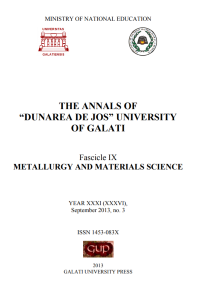Recycling of Integrated Steel Plant Solid Wastes in the Sintering Process and Corresponding Effects on Pollutant Emissions
Abstract
The new practices in sintering technology allows for the use of a wide range of iron-containing materials in charge with obtaining the agglomerate with necessary characteristics for optimal operation of the blast furnace. The essential modifications in the composition of feed materials have an important impact on the nature and the quantity of pollutant emissions from the sintering plant. In this paper is presented an analysis of emissions and of their mechanism formation for the case of the sintering sector from an integrated steel mills, which transformed into agglomerate a variety of materials as iron ore fines, dust collected from blast furnace, ore concentrates and some fractions of metallurgical slag. These are correlated with operation conditions in sinter strand and of other main sections of the process.
Downloads
References
[2]. ***, Integrated pollution prevention and control. Draft reference document on best available techniques for the production of iron and steel, draft February 2008, http://eicppb.jrs.es.
[3]. R. Rainer, M. A. Aguado-Monsonet, S. Roudier, L. Delgado Sanch - Best Available Techniques (BAT) Reference Document for Iron and Steel Production. Industrial Emissions Directive 2010/75/EU (Integrated Pollution Prevention and Control), (2013), http://eippcb.jrc.ec.europa.eu/reference/BREF/IS_Adopted_03_2012.pdf.
[4]. ***, Guidelines on Best Available Techniques (BAT) for Sinter Plants in the Iron Industry, section V.D.2: Sinter Plants in the iron industry, www.pops.int/.../draftguide/5d2ironsinteringdra.
[5]. A. M. Ftodiev - Emisii poluante survenite in timpul procesului de aglomerare al minereurilor de fier din ArcelorMittal Galati, proiect GPPEP, (2013).
[6]. B. Das, S. Prakash, P. S. R. Reddy, V. N. Misra - An overview of utilization of slag and sludge from steel industries, Resources, Conservation and Recycling, Volume 50, Issue 1, March 2007, p. 40-57.
[7]. ***, http://www.worldsteel.org/.
[8] ***, Iron Unit Recycling, http://www.metalpass.com/metaldoc/paper.aspx?docID=89.
[9]. ***, EC BREF on the Production of Iron and Steel, http://www.epa.ie/pubs/advice/bref/Iron%20&%20Steel.pdf, 2001.
[10]. N. R. Passant, M. Peirce, H. J. Rudd, D. W. Scott, I. Marlowe, J. D. Watterson - UK Particulate and Heavy Metal Emissions from Industrial Processes, A report produced for the Department for Environment, Food & Rural Affairs, the National Assembly for Wales, the Scottish Executive and the Department of the Environment in Northern Ireland, AEAT-6270 Issue 2, February (2002).
[11]. M. Nakano, J. Okazaki - Influence of Operational Conditions on Dust Emission from Sintering Bed, ISIJ International, Vol. 47 (2007), no. 2, p. 240-244.
[12]. A. Ciocan, Generarea și controlul emisiilor poluante industriale, GUP Galati, 2013.
[13]. N. Tsubouchi, S. Kuzuhara, E. Kasai, H. Hashimoto, Y. Ohtsuka - Properties of Dust Particles Sampled from Windboxes of an Iron Ore Sintering Plant: Surface Structures of Unburned Carbon, ISIJ International, Vol. 46 (2006), no. 7, p. 1020-1026.



